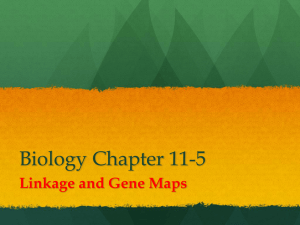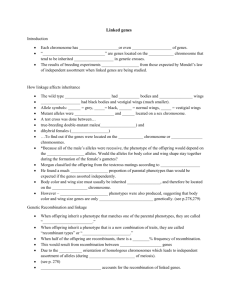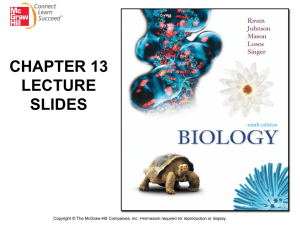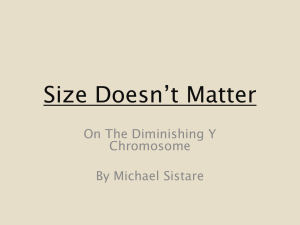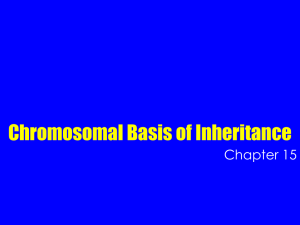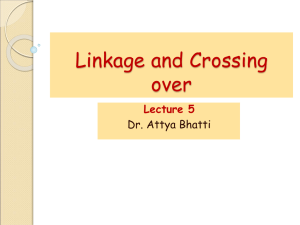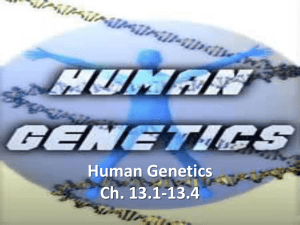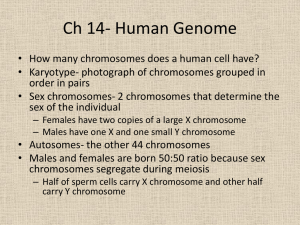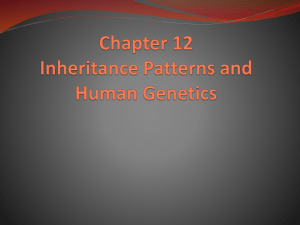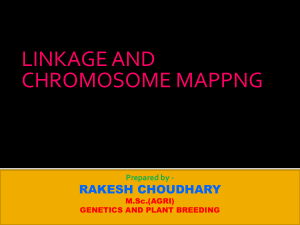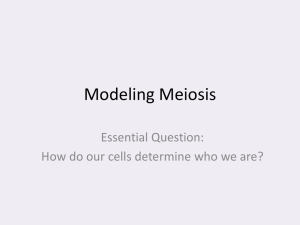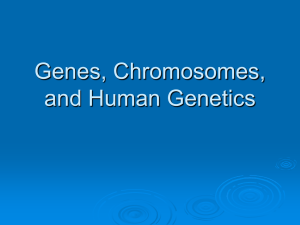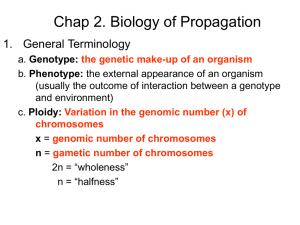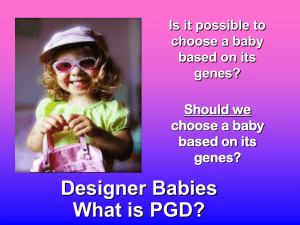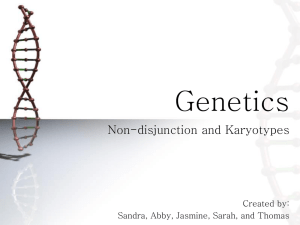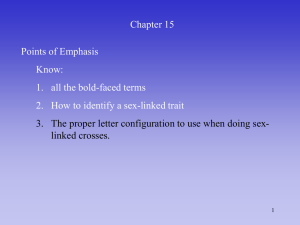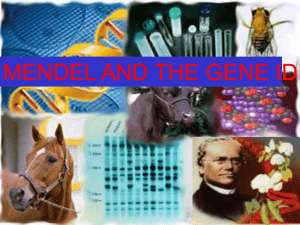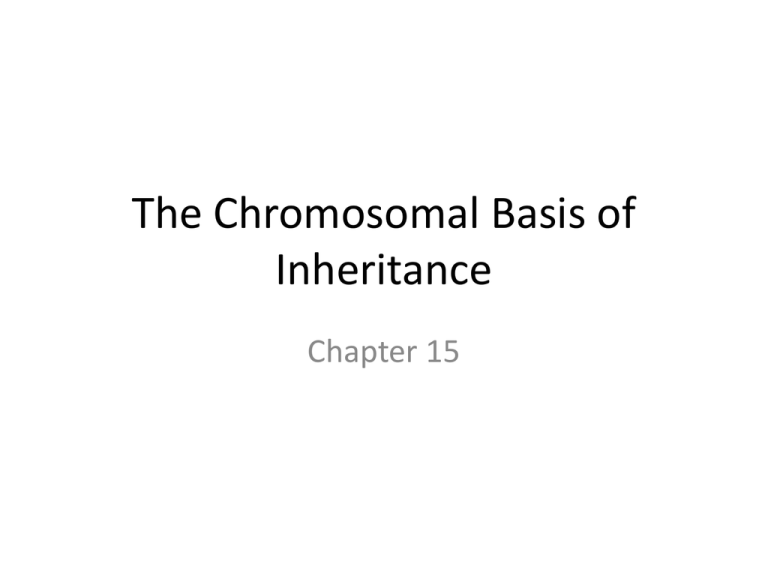
The Chromosomal Basis of
Inheritance
Chapter 15
Review
•
•
•
•
•
Mitosis
Meiosis
Chromosome
Genotype and Phenotype
Mendelian Genetics
Thomas Hunt Morgan
• Studied Drosophila
melanogaster
– Large number of
offspring
– Small, easy to care for
– 4 chromosomes with
easily observable
phenotypes
Drosophila melanogaster Phenotypes
• Wild type: red eyes
• Variations: eye color, body color, wing shape
• Males and females are easy to tell apart
Morgan’s Cross
• Red eyed female x White eyed male
(w+)
(w)
• F1 100% red eyed (wild type)
• F2 3:1 ratio BUT only males had white eyes
Morgan’s Conclusion
• The gene for eye color must be carried on the
X chromosome and NOT an autosome
• Higher probability of a male having the
recessive phenotype
Sex Linked Traits
Color Blindness
• Xb = No color blindness
• XB = color blindness
• Determine the crosses (both phenotype and
genotype) for the following crosses
1. Color blind father x normal mother yields one
color blind son.
2. Normal father, carrier mother.
3. Normal father, color blind mother.
4. What cross will yield a color blind daughter?
Sex Linked Traits
• Called hemizygous
• Do occur in females but males have a higher
probability of inheriting the trait
• Duchenne muscular dystrophy, hemophilia,
color blindness
X Inactivation in Females
• Having two X chromosomes is a lot of genes!
• One X chromosome will be turned off
– Barr body: X chromosome condenses and will be
near the nuclear envelope
– Ovaries – Barr body will be duplicated for viable
egg cells
– In development, different X chromosomes could
be turned off
• About ½ of the cells display the mother’s traits and half
display the father’s
Review of Pedigrees and Blood Typing
Linked Genes
• Genes on the
same
chromosome that
tend to be
inherited together
• Morgan believed
body color and
wing shape were
inherited together
Genetic Recombination
• Recombinant: Offspring show combinations of
traits not found in the parents
• How does this happen?
Recombinants
• Mendel’s peas
• YyRr x yyrr
– Complete the punnett square for the above cross.
• Which genotype and phenotypes are
recombinants? Which are parental types?
Crossing Over
• During Meiosis I (Prophase I)
• Homologous chromosome pairs come
together forming a tetrad
– Crossing over
• Each chromosome will cross with the other in the pair
• Parts of the chromosome will be exchanged
Recombination Frequency
• How likely is it that the two genes will be
linked?
• Based on how close they are on the
chromosome
– Closer they are, more likely they will be linked
• Linkage map: genetic map based on
recombination frequency
Linkage Mapping Problem
Mating: AaBb x aabb
• A = Long antennae
• a = Short antennae
• B = Green eyebrows, and
• b = Blue eyebrows.
Say you make this mating, and your actual results look like
this:
• Long Green - 850
• Long Blue - 150
• Short Green - 150
• Short Blue - 850
Calculate Linkage Map Distance
• One linkage map unit (LMU) is 1% recombination.
Thus, the linkage map distance between two
genes is the percentage recombination between
those genes.
• In this case, we have a total of 300 recombinant
offspring, out of 2000 total offspring. Map
distance is calculated as (# Recombinants)/(Total
offspring) X 100.
• What is the LMU of the two genes?
Linkage Map Summary
1. How can you recognize when genes are
linked?
2. How do you calculate linkage map distance?
3. What does the linkage map distance tell you?
4. How does a linkage map relate to
independent assortment of genes?
Linkage Map for Drosophila
melanogaster
Dihybrid Cross
• In summer squash, white fruit color (W) is
dominant over yellow fruit color (w) and diskshaped fruit (D) is dominant over sphereshaped fruit (d). If a squash plant truebreeding for white, disk-shaped fruit is
crossed with a plant true-breeding for yellow,
sphere-shaped fruit, what will the phenotypic
and genotypic ratios be for the F1 generation
and the F2 generation?
F1
F2
Summary of Dihybrid Cross
• White color (W) is dominant over yellow fruit
color (w) and disk-shaped fruit (D) is dominant
over sphere-shaped fruit (d)
Chi Square (X2) Test
• Determines statistical significance of a set of
data
• Use in genetics: if genes sort INDEPENDENTLY
they will follow the expected ratios of
domintant : recessive
– If not, they will not follow expected ratios and we
would reject the null hypothesis
Chi Square Set Up
Phenotype
Genotype
#observed
#expected
observed –
expected
(o-e)
(o-e)2
(o-e)2 / e
Exit Ticket
Baby chicks are pecking at grains of cracked corn of
different colors. A researcher is attempting to determine
if they have a preference for one color over another. He
counts the number of grains chosen in an arena that has
equal numbers of red, blue, green and yellow corn
chunks. Here are his results:
–
–
–
–
red: 250
blue: 220
green 230
yellow 240
Perform a Chi Square analysis on these results. Can he
reject the null hypothesis of no preference? Explain your
answer.
Monohybrid Cross Practice Problem
• A student makes a monohybrid cross with Drosophila.
She crosses two heterozygotes for the white eye. Ww x
Ww. She expects to see a 3:1 phenotypic ratio of Red
eyes (WW and Ww) to white eyes (ww), her null
hypothesis. She rears the next generation through to
adult flies and counts the following numbers:
– White eyes 210
– Wild type 680
• What change occurs in the allelic frequencies between
generations 1 and 2? Perform a chi square analysis on
these results and find out if it is close enough to 3:1 to
fail to reject her null hypothesis. Make sure to show all
work and explain your conclusions.
Dihybrid Chi Square Problem
In the garden pea, yellow cotyledon color is
dominant to green, and inflated pod shape is
dominant to the constricted form. Considering both
of these traits jointly in self-fertilized dihybrids, the
progeny appeared in the following numbers:
–
–
–
–
193 green, inflated
184 yellow constricted
556 yellow, inflated
61 green, constricted
Do these genes assort independently? Support your
answer using Chi-square analysis.
15.4 Alterations of chromosome
number or structure cause some
genetic disorders
Abnormal Chromosome Number
• Nondisjunction:
chromosomes do
not separate
correctly
– Meiosis I or II
Aneuploidy
• Gamete with abnormal number of chromosomes
unites with a normal gamete
• Offspring will have abnormal number of
chromosomes
• Monosomic (2n – 1); Trisomic (2n + 1)
– Change in number of copies of chromosomes – only
changes the chromosome number by 1
• Polyploidy: triploidy (3n), tetraploidy (4n)
– Extra copies of COMPLETE sets of chromosomes
– Will cause chromosome numbers to be doubled or
halved
Chromosomal Mutations
• Involve changes in the number or structure of
chromosomes
• 4 types:
– Deletion
– Duplication
– Inversion
– Translocation
Deletion and Duplication
• Deletion:
– Loss of all or
part of a
chromosome
• Duplication:
– Produce extra
copies of the
chromosome
Inversion and Translocation
• Inversion:
– Reverse direction of
parts of the
chromosome
• Translocation:
– Part of one chromosome
breaks off and attaches
to another chromosome
Human Disorders caused by
Chromosomal Alterations
•
•
•
•
•
•
Turner Syndrome
Down syndrome
Cri du chat
Prader-Willi Syndrome
Huntington’s Disease
Angelman Syndrome
Inheritance Patterns
• Not all fall into set patterns of equal
inheritance
• Genomic Imprinting
– Effect of the allele for a certain trait depends on
which parent passed on the trait
– Could be expressed in different strengths
Organelle Genes
•
•
•
•
Extranuclear genes (found in cytoplasm)
Mitochondrial genes
Chloroplast genes
NOT distributed to the offspring in the
Mendelian fashion
• Come from mother – why?
Mitochondrial Genes
• Most make up the ETC and ATP synthase
• Defects in these genes will affect energy
production
– Most severely nervous system and muscular
system
Review Topics
•
•
•
•
•
Genetics and probability
Alleles and allele frequency
Observes and expected phenotypes
Sex linked traits (hemizygous) / Linked genes
Recombination (frequency of recombination =
probability of recombination)
• Chi square analysis
• Types of chromosomal mutations
• Genomic Imprinting (1)
Kleinfelter Syndrome
•
•
•
•
•
•
47 chromosomes
XXY
Male sex organs - small testes, sterile
Feminine body characteristics
Taller than average
No mental disability


